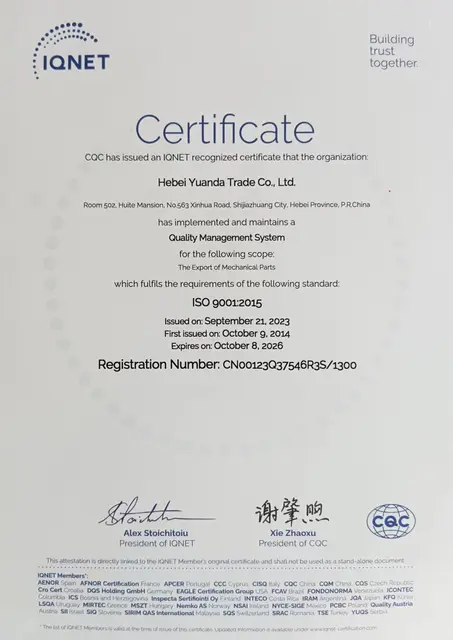Mobile:+86-311-808-126-83
Email:info@ydcastings.com
A Comprehensive Guide to A356 Aluminum Casting Properties and Applications
A356 Aluminum Casting The Material of Choice for Versatile Applications
A356 aluminum is a versatile alloy commonly used in casting applications due to its excellent mechanical properties, good corrosion resistance, and ease of fabrication. This aluminum alloy contains silicon and magnesium, which contribute to its strength and ductility, making it suitable for various industries, including automotive, aerospace, and marine.
Composition and Properties
A356 aluminum is primarily composed of aluminum (90.7% to 92.7%), with silicon (6.5% to 7.5%) and magnesium (0.25% to 0.45%) being the key alloying elements. The silicon content enhances fluidity during the casting process, allowing intricate shapes and designs to be molded accurately. Meanwhile, the magnesium content improves the mechanical strength of the alloy, particularly in high-temperature environments.
The mechanical properties of A356 aluminum casting are impressive. It exhibits a tensile strength of approximately 240 MPa and a yield strength of about 210 MPa. It can withstand significant deformation, making it suitable for complex geometries. Moreover, with a Brinell hardness ranging from 70 to 120 HB, it also provides excellent wear resistance, which is crucial in applications subjected to high friction or abrasive conditions.
Casting Methods
Various casting methods can produce A356 aluminum components, each offering unique advantages
. The most common techniques include sand casting, investment casting, and die casting.1. Sand Casting This method is widely used due to its flexibility and cost-effectiveness. Sand molds are created by packing sand around a pattern. This technique is particularly beneficial for low-volume productions and complex shapes, making it suitable for prototype development.
a356 aluminum casting

2. Investment Casting This precision casting method provides high accuracy and excellent surface finish. It involves creating a wax pattern that is coated with a ceramic shell. Once the shell is hardened, the wax is melted away, leaving a cavity for the molten aluminum to fill. Investment casting is ideal for intricate designs requiring tight tolerances.
3. Die Casting This process is used for high-volume production runs where consistency and repeatability are crucial. Molten aluminum is injected into a steel die under high pressure, resulting in precise and uniform components. Die casting is particularly advantageous for parts requiring intricate detailing and smooth surfaces.
Applications in Various Industries
A356 aluminum casting finds applications across a wide range of industries. In the automotive sector, it is used for manufacturing lightweight components such as wheels, engine blocks, and transmission housings. The lightweight nature of the alloy contributes to improved fuel efficiency while maintaining structural integrity.
In aerospace, A356 aluminum is favored for its strength-to-weight ratio, making it suitable for aircraft components like landing gear and airframe structures. The alloy’s performance in high-stress environments and its resistance to corrosion enhance safety and reliability in flight.
The marine industry also benefits from A356 aluminum due to its corrosion resistance and durability. Boat hulls, propellers, and various fittings made from this alloy can withstand harsh marine conditions, ensuring longevity and performance.
Conclusion
In summary, A356 aluminum casting is a versatile and reliable choice for various applications due to its excellent mechanical properties, good corrosion resistance, and adaptability to multiple casting methods. Its widespread use in industries such as automotive, aerospace, and marine underscores its importance in modern manufacturing. As technology advances and the demand for lightweight, high-strength materials increases, A356 aluminum casting is poised to remain a material of choice for engineers and designers alike, driving innovation and efficiency in production processes. Whether it’s for prototypes or mass production, A356 aluminum casting continues to offer solutions that meet the challenges of contemporary design and engineering.
-
Understanding Metal Casting TechniquesNewsApr.02,2025
-
Understanding Exhaust Manifolds for Enhanced Engine PerformanceNewsApr.02,2025
-
The World of Metal FabricationNewsApr.02,2025
-
Key Components for Pump and Turbo EfficiencyNewsApr.02,2025
-
Essential Tools for Automotive Maintenance and RepairNewsApr.02,2025
-
Durable Valve Components for Effective Water ManagementNewsApr.02,2025











